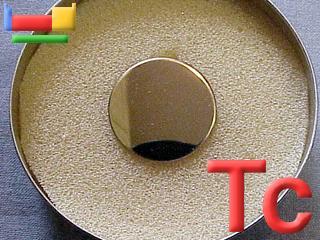|
|
| Technetium is a silvery-gray metal that tarnishes slowly in moist air. The common oxidation states of technetium are +7, +5, and +4. Under oxidizing conditions technetium (VII) will exist as the pertechnetate ion, TcO4-. The chemistry of technetium is said to be similar to that of rhenium. Technetium dissolves in nitric acid, aqua regia, and conc. sulfuric acid, but is not soluble in hydrochloric acid of any strength. The element is a remarkable corrosion inhibitor for steel. The metal is an excellent superconductor at 11K and below. There are twenty-two reported isotopes of technetium with masses ranging from 90 to 111. All the isotopes of technetium are radioactive. It is one of two elements with Z < 83 that have no stable isotopes; the other element is promethium (Z = 61). Technetium has three long lived radioactive isotopes: 97Tc (T1/2 =2.6 x 106 years), 98Tc (T1/2 = 4.2 x 106 years) and 99Tc (T1/2 = 2.1 x 105 years). 95Tcm ("m" stands for meta state) (T1/2 = 61 days) is used in tracer work. However, the most useful isotope of technetium is 99Tcm (T1/2 = 6.01 hours) is used in many medical radioactive isotope tests because of its half-life being short, the energy of the gamma ray it emits, and the ability of technetium to be chemically bound to many biologically active molecules. Because 99Tc is produced as a fission product from the fission of uranium in nuclear reactors, large quantities have been produced over the years. There are kilogram quantities of technetium.
Applications The most useful isotope of technetium is technetium-99m: it has a short half-life and it binds chemically to many biologically active molecules, these properties make it suitable for many medical radioactive isotope tests. When Tc-99m is combined with a tin compound it binds to red blood cells and can therefore be used to map circulatory system disorders. A pyrophosphate ion with Tc-99m adheres to calcium deposits in damaged heart muscle, making it useful to gauge damage after a heart attack. The sulfur colloid of Tc-99m is scavenged by the spleen, making it possible to image the structure of that organ.Like rhenium and palladium, technetium can serve as a catalyst. For certain reactions, for example the dehydrogenation of isopropyl alcohol, it is a far more effective catalyst than either rhenium or palladium. Of course, its radioactivity is a major problem in finding safe applications. Technetium-99 has also been proposed for use in optolectric nuclear batteries |
